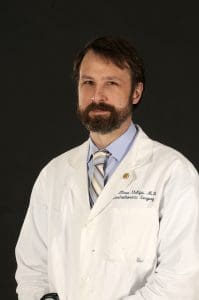Dedicated Team Helps Patients Stop Smoking
| Sept. 13, 2017 | It was just a chance encounter on a Friday evening, but that fateful meeting has had quite an impact on tobacco cessation research and work in Arkansas.
Seven years ago, Claudia Barone, D.N.P., Ed.D., A.P.R.N., a professor in the UAMS College of Nursing and a certified tobacco treatment specialist, was at UAMS Medical Center chatting with a patient waiting to be picked up by her husband. The patient, who smoked, mentioned a wound that wasn’t healing properly. Barone used that as an opportunity to segue to the possibility of quitting smoking.
As she began to counsel the patient on how she could go about quitting, she noticed a doctor in her peripheral vision watching her interaction with the patient. It was Matthew Steliga, M.D., a thoracic surgeon in the UAMS Winthrop P. Rockefeller Cancer Institute, and he was struck by Barone’s ability to speak with patients about tobacco cessation.
The two introduced themselves, exchanged pleasantries and were gone. A few weeks later, Steliga reached out to Barone about the possibility of obtaining research funding from the Arkansas Cancer Coalition.
The rest is history.
They added members to the team in Pat Franklin, A.P.R.N., certified tobacco treatment specialist; Linda Cullers, tobacco cessation interventionist; and Erna Boone, Dr.P.H., an associate professor in the UAMS College of Health Professions and a certified tobacco treatment specialist.
For the next four years, the team received more than $260,000 from the Arkansas Cancer Coalition for tobacco cessation research.
Those years of funding have created a tight-knit group dedicated to helping patients and UAMS employees quit smoking. The team staffs several clinics at UAMS, including surgery, oncology, pulmonary and cardiology, and conducts health screenings, counseling numerous patients through the process of quitting.
On average, about 30 patients a month agree to a quit attempt, said Barone.
“Clinical guidelines tell us the more times a patient hears about the importance of quitting, the more likely that patient is to have a quit attempt,” said Barone.
Once a person agrees to a quit attempt and sets a date, the group follows up throughout the attempt to check in with the participant and offer encouragement.
“We provide an avenue for them to quit and reinforce that with follow-up calls and support,” said Cullers. “We try to identify barriers and help them be successful in their quit attempt.”
According to the group’s most recent survey, it achieved a 14 percent quit rate.
“That doesn’t always sound like a great achievement, but the quit rate without any guidance or intervention is about 2 percent, so that’s a pretty good increase in results,” said Steliga. “We’ve all learned this isn’t an easy process, but you cannot get discouraged in this type of work. You have to keep working.”
The group’s survey found more than 50 percent of its participants reported reducing the amount they smoked.
“Reduction is a great way to achieve abstinence,” said Barone. “Often, patients will reduce to one or two cigarettes and then stop completely; cessation from tobacco can span over a 30- or 60-day timeframe.”
There isn’t a one-size-fits-all approach to quitting tobacco. Each participant is involved in creating his or her quit attempt strategy.
“Every plan is highly individualized,” said Barone. “If we want the patients to be successful, we have to empower them and get them to buy into their cessation plan.”
Franklin conducts American Lung Association Freedom from Smoking support groups, open to the general public and employees, to help encourage a successful quit attempt.
The free, seven-week course offers one-on-one support for participants. The weekly sessions also allow participants to hear from fellow group members and former smokers, as well as gain information on nicotine replacement therapies, healthy eating habits and stress management.
“There are three weeks of preparation for the quit attempt, then, a quit date and three additional weeks after the quit date,” said Franklin. “That’s beneficial to the participants because one of the hard things about quitting is being able to establish a quit date. This motivates them to establish a date and work toward it.”
In addition, Barone and Boone have worked on improving the tobacco cessation infrastructure at UAMS. Both are certified to offer the Tobacco Treatment Specialist Program from the University of Massachusetts Medical School’s Center for Tobacco Treatment Research & Training.
Those who complete the training, which is offered twice a year, earn the certified tobacco treatment specialist (CTTS) credential.
“One of the most exciting characteristics of tobacco treatment is that it is an interprofessional activity,” said Boone. “We have had physicians, nurses, dental hygienists, pharmacists, respiratory therapists and health educators complete the program. Any health care provider who comes into contact with tobacco-using patients will benefit from having this training.”
No matter whether it’s a health screening, an inpatient or clinic consultation or a Freedom from Smoking Support Group, the team wants to see more people quit tobacco use.
“For those who are successful, it means so much to them,” said Steliga. “They’re not just living a longer life, but a better life.”

